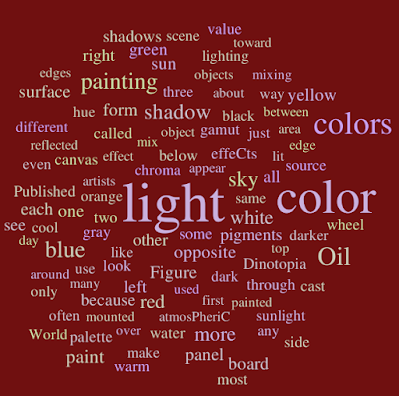Here's the word cloud for my book “Color and Light: A Guide for Realist Painters.” It appears the title accurately represents what's inside.
Here's “Imaginative Realism: How to Paint What Doesn’t Exist.” The reason the word "imagination" doesn't appear in the cloud is that the book is focused less on where ideas come from and more on practical methods for how to take a vague idea and make it real.
Finally here's John Ruskin's "Modern Painters." Even though he was a practicing artist, Ruskin doesn't really discuss the nuts and bolts of practical picture-making, but instead dwells in loftier realms of abstract, ideal principles. Art is almost a religion for Ruskin.
If you're interested in the ideology that drove realist painters, I would recommend reading The Art Spirit by Robert Henri, The Classic Point of View by Kenyon Cox, or Aims and Ideals of Art by George Clausen (Also available on Archive.org). Any other books on art and ideology that you would recommend — or not recommend?
----
Read moreColor and Light: A Guide for Realist Painters
Imaginative Realism: How to Paint What Doesn’t Exist
Exhibition catalog: The New Path: Ruskin and the American Pre-Raphaelites










4 comments:
A tad bit off-topic, but I was just thinking of your two books: Color and Light and Imaginative Realism in reference to markers. I want to buy a small set of markers from Amazon and was wondering whether you had any opinions concerning Berol vs Copic markers? Or are there others, not necessarily big names, you could recommend?
Great question, James. On the "recommend" front, and not specifically about art (but all about art), Robert Pirsig's Zen and the Art of Motorcycle Maintenance was the first book that got me thinking about what is good, what is not good, and why do I like what I like. Also, The Art Instinct by Denis Dutton is a thoughtful discussion of art and aesthetics from the perspective of human evolution, which is always intriguing.
James, great topic!
I recommend "Sculpting in Time" by Andrei Tarkovsky, an immensely talented Russian filmmaker (Stalker [1979], Solaris [1972] etc.). Part autobiography, part philosophical treatise on filmmaking and art in general. It's a dense book that applies to all art, not just film.
From the book:
“The allotted function of the artist is not, as is often assumed, to put across ideas, to propagate thoughts, to serve as example. The aim of art is to prepare a person for death, to plough and harrow his soul, rendering it capable of turning to good.”
“The function of the image, as Gogol said, is to express life itself, not ideas or arguments about life. It does not signify life or symbolise it, but embodies it, expressing its uniqueness.”
awesome topic ,come back later to read more
Post a Comment